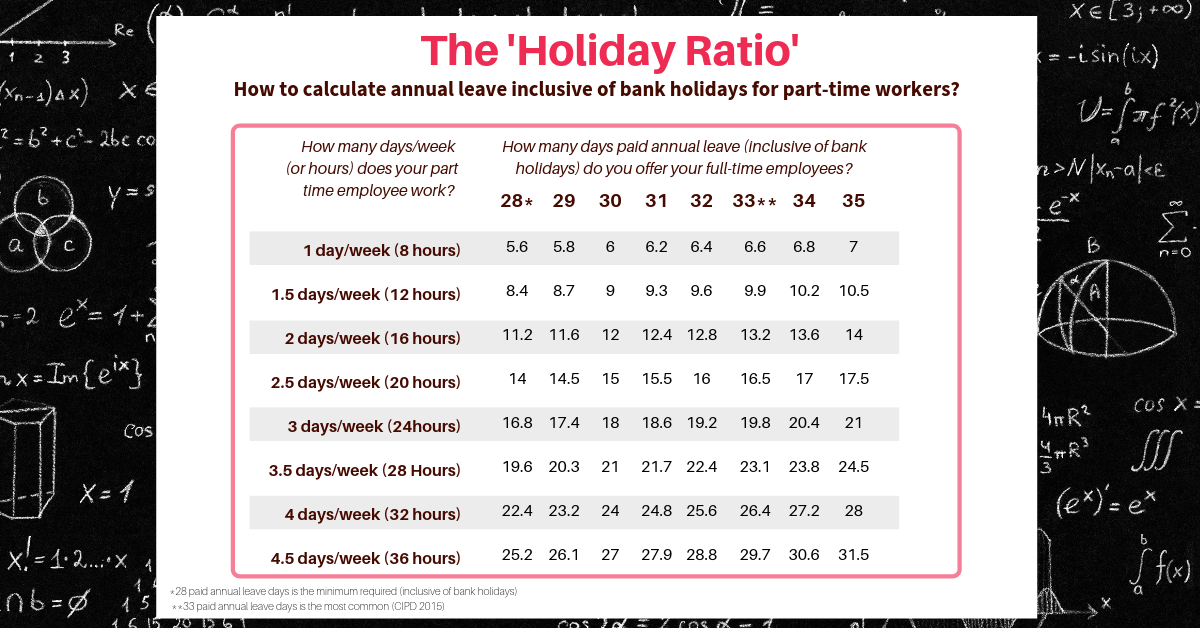Bank Holiday Entitlement for Part-time Employees
As a part-time recruitment consultancy, we’re often asked by our client companies about ways to calculate and manage bank holiday entitlement for part-time workers. You probably already know that all full-time employees are entitled to at least 28 days paid annual leave, which may or may not include bank holidays. You may also know that part-time employees are entitled to a pro-rata calculation of the same holiday entitlement as full time employees.
But what about part-time bank holiday entitlement?
Do I have to give employees time off for bank holidays?
Employers do not legally have to give their full-time or part-time employees time off work on bank holidays. In fact, many employers in the retail industry or emergency services require their employees to work on bank holidays. Likewise, employers do not have to pay employees extra for working on a bank holiday.
Do I include bank holidays in annual leave?
Whether your employees are full-time or part-time, as an employer, you decide whether or not to include bank holidays within their statutory annual leave allowance. The simplest way to deal with bank holidays is to write them into the employee’s contract, setting out the rules for annual leave and bank holidays.
For example, you could decide to include all eight bank holidays within the employee’s minimum annual paid leave:
“Your annual holiday entitlement (inclusive of bank and public holidays) is 28 days”
This would mean all employees would have to take bank holidays as part of their paid annual leave. A full-time employee with the minimum holiday entitlement would have 20 paid holiday days and 8 ‘fixed’ paid bank holiday days.
Alternatively, you may decide to offer a more generous annual leave package which can help attract, motivate and retain employees:
“In addition to bank and public holidays, your annual entitlement to holidays is 25 days”.
This would mean you pay all bank and public holidays in addition to 25 paid holiday days giving your employees more overall annual leave (33 days in total) and allowing your employees more flexibility as to when they take their paid holiday days.
Two-thirds of UK organisations offer at least 25 paid holiday days, excluding the 8 bank holidays, or a total of 33 days paid annual leave.
How to calculate minimum holiday entitlement for part-time workers?
Whether you decide to include bank holidays in the annual holiday allowance or not, you should know that for all employees, minimum statutory holiday entitlement is calculated by multiplying the number of days worked per week by a minimum factor of 5.6. The result, which is capped at 28 days (even if an employee works 6 or 7 days a week), is the minimum number of days of annual leave that the worker is statutorily entitled to.
Employers must ensure that all employees have at least the statutory minimum holiday allowance and that part-time employees are not treated less favourably than full-time employees.
To calculate the minimum part-time annual leave, you multiply the number of days worked in a week by the same 5.6 factor. For example, if a part-time employee works two days a week, then the calculation is 2 x 5.6 = 11.2, meaning the worker gets 11.2 days annual leave. This would usually be rounded up to 11.5 or 12 days annual leave to keep things simple.
If as an employer you have decided to offer more than the minimum of 28 days holiday entitlement to your full-time employees, for example a total of 33 days annual holiday entitlement including bank holidays, the ‘holiday ratio’ increases to 6.6 (33 holiday days/5 work days).
The part-time employee working two days a week would now be entitled to 2 x 6.6 = 13.2 days annual leave. This can be rounded up to 13.5 days (but does not have to be) but cannot be rounded down.
Check out our ‘Holiday Ratio’ table below to calculate total annual leave inclusive of bank holidays for part-time workers.

How to calculate pro-rata bank holiday entitlement for part-time workers?
If you wish to separately calculate pro-rata bank holiday entitlement for part-time workers, first look at how many bank holidays your full-time workers get. This is often eight paid bank holidays. If they work a 40 hour week, these employees are receiving 64 hours’ worth of bank holiday leave. (8 days X 8 working hours per day).
If your part-time employee who works two-days were to get their bank holidays paid, the calculation would be how many hours they work (16 hours) divided by the number of hours in a working week (40 hours) multiplied by 64 (the bank holiday leave entitlement for all staff x regular hours in working day). So the calculation would be (16/40) X 64 = 25.6 hours.
To recap, that’s: (Number of hours worked per week on a part-time basis/number of hours in a full-time week) x (full-time bank holiday entitlement x number of full-time hours per working day).
Or in terms of days, the calculation would be 2/5 X 8 = 3.2 days.
How to manage bank holiday entitlement for part-time workers?
Part-time staff have the same entitlement to leave as full-time workers. Therefore, if full-time staff are given paid leave for bank and public holidays, part-time workers should also receive this benefit on a pro-rata basis.
A question may arise when you have a part-time worker who works for example two days a week, but never on a Monday or Friday, compared to another employee who also works part-time but on a Monday and Friday.
Example:
Employee A works part time two days/week on Tuesday and Thursday.
Employee B works part time two days/week on Monday and Friday.
Full-time employees are entitled to 33 days holiday entitlement including bank holidays. The ‘holiday ratio’ is 6.6 (33 holidays/5 workdays).
Both part-time employees are entitled to a total of 13.2 days annual leave (2 x 6.6).
Employee A can take 13.2 days holiday leave when they choose.
Employee B would deduct 7* of the 13.2 days annual leave for the Monday and Friday bank holidays.
*In 2020, 4 of the 8 bank holidays are on a Monday, 3 on a Friday and 1 on a Wednesday.
UK 2020 bank holiday dates
If you’ve enjoyed the recent 2019 August bank holiday, here’s a little look ahead to 2020 Bank Holidays. The early May Day holiday has been moved next year to coincide with the 75th anniversary of VE Day.
| 1st January | Wednesday | New Year’s Day | |
| 10th April | Friday | Good Friday | |
| 13th April | Monday | Easter Monday | |
| 8th May | Friday | May Day | |
| 25th May | Monday | Late May Bank Holiday | |
| 31st August | Monday | August Bank Holiday | |
| 25th December | Friday | Christmas Day | |
| 28th December | Monday | Boxing Day |
We should stress that here at Ten2Two, we are not HR specialists. We are a recruitment agency so please always contact an HR specialist for specific advice around legal employment concerns, including queries about your annual leave entitlement.
Find part-time professionals the easy way
If you’d like to find part-time professionals to grow your business or to build your in-house expertise or even to attack those tasks you’ve been putting off, Ten2Two can help. Please contact us today and we’ll be happy to talk through your recruitment requirements.


 Back to resources
Back to resources 6 min read
6 min read








